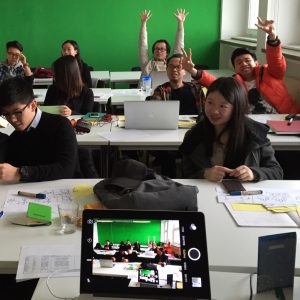How many words do you understand right away? Words matter. Wording and terminology make a difference in usability and user experience. If you struggle with words then you’ll also perceive a poor usability of a product or service. Jargon includes or excludes people from certain groups. Hence, as a designer please pay attention to the terminology in your product.

A class of Chinese students has fun with recursive displays.
When I teach in front of Chinese students at the Brand Academy in Hamburg – although their German is much better than my Chinese – I am always aware of the issue that some thoughts might get lost or might change their intended meaning on the way from me to them. I mean, this can always be the case and it is astounding that communication works at all. But in this setting it is pretty clear that we have in addition to all language issues also a cultural gap that runs right through the middle of the class room. We have a different background just for instance because of the different TV shows we watched while growing up. The next generation might even ask, „what is TV?“
User Experience is what happens inside the user of a system or service before, during and after she uses the product or service. If you take teaching as a service then you can apply UX design principles also to the situation in the class room. In this setting inclusion means that the lecturer’s aim is to reach each and every student regardless of any circumstances like language, gender, age, prior education, home sickness or world championships in any kind of weird sports. I see inclusion as a humanistic attitude to respect and love your audience.
Well-designed user experiences allow for the uniqueness of people’s different strengths and believe to co-exist in a place of similarity and common ground. Tools and technologies that embrace similarities to tap into the potential of all people creates conditions that promote people to be their best selves, to cultivate and nurture people will produce better outcomes in all we do. – worldusabilityday.org 29-Oct-2017
What? “user experiences…believe…” what? This is taken from this year’s home page of the world usability day. After pointing out my problem the authors confessed that they do not understand either. Here is my proposed update:
Well-designed systems and services offer great user experiences for all kind of people regardless of their background, their education, or their current situation. Each one has different strengths and weaknesses that should not exclude him or her from participating in professional or social life via communication technology. Tools and technologies that embrace similarities to tap into the potential of all people create conditions that promote people to be their best selves; designing usable tools to support people will produce better outcomes in all we do.
I hope this is an improvement. I hope this paragraph can be understood and you agree to the intended meaning.
Have you already scheduled your World Usability Day? We can even meet at our panel on Innovation though Inclusion. How many words do you…?

A spiffy computer mouse. Sometime it can be quite hard to empathize with the user.